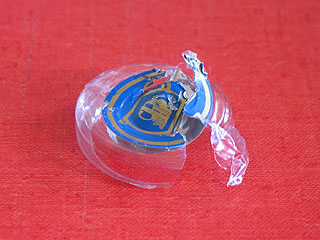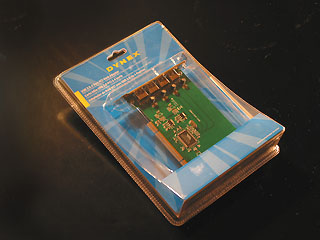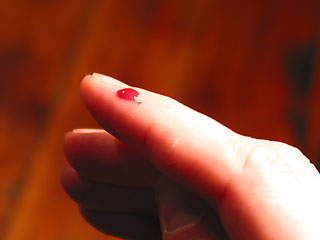
In a recent interview, Michael Beirut noted that wine labels are one of the purest branding experiences: All wine bottles contain the same basic product (wine), so if you don’t know anything about a particular bottle of wine the graphic design of the label and the shape of the bottle are quite often the only methods you have (besides whatever knowledge you might have of the intricate and faceted namespace of wine metadata) to decide whether or not you should buy that Burgundy.
In other words, packaging is a fundamental part of the overall customer experience (aka the user experience). Whether contemplating, holding, carrying, opening, or unpacking a product, it’s “packaging” is everything between (a) the time the customer didn’t even know they wanted it to (b) the first moment actually using what they’ve bought.
And the best (and worst) practices of physical product packaging are, I think, applicable to the digital/virtual product user experience, too.
Here’s an example from the physical world: The other night I opened a bottle of Rioja with a rather unorthodox cork, and I was reminded again of just how much the experience of merely opening a product is one of the most powerful opportunities available to a user experience designer.
The Rioja’s actual cork was perfectly traditional and conventional, but the plastic seal enveloping it so closely hugged the bottle’s lip, and was made of such stiff, thick plastic, that it took me several profanity-laden minutes to finally wrestle the plastic seal from the cork. The whole time my excitement about tasting this new wine turned into resentment towards the brand. A perfectly good branding opportunity utterly ruined by thoughtless user experience design.
Hostile Packaging

Sometimes packaging goes from mere thoughtlessness to downright hostility towards the customer. The day after the Rioja nightmare, I purchased a new USB PCI card for my computer, and was again confronted with a packaging nightmare.
Yes, it’s one of those dreaded clamshell blister packs deliberately designed, it seems, to slice customers’ hands open. I at first took the product here just to show another familiar example of user-unfriendly packaging. But then I started opening it and the example proved itself spectacularly. I tried scissors and an X-acto knife before I finally had to grab a powerful box cutter to cut through the steel-like plastic.
Look, I’m fairly skilled with my hands. I majored in sculpture in college, for crying out loud. How in the world do people without my kind of skills, and presumably without the necessary cutlery tools, actually open these packages without cutting themselves in the process?

Turns out the answer to that question is moot: I cut my finger opening the package — which suggests to me that a very large percentage of other customers must do the same. Is this possible? Can a brand survive when their products spill their customers’ blood? Apparently so, since this packaging is still in wide use. But do I have anything positive to say about these brands? Nope.
In fact, it’s probably no coincidence that I cannot even name any brand whose products come in this style of packages. If holding and opening a new product is a branding moment, shouldn’t opening that product be an opportunity for me to feel good about the brand? Instead of me writing them off as no-name, second-tier junk?
Compare these packaging nightmares/experiences to (naturally) any Apple product, where the box is easy to open, the first exposure to the item itself feels like a revelation, and most importantly the product itself can be touched and admired within seconds.
There’s even a word for this: unboxing. Technology review sites like Engadget and Gizmodo make sure to specifically evaluate the unboxing experience as part of their overall product reviews. In fact, many consumers are so enamored by the unboxing experience of their products that they have created web communities centered around sharing their unboxing experiences with the world, often in obsessive compulsive detail.
Opening the Software Bottle
It’s easy to imagine how these very different modes of thinking about the hardware customer experience translates into interactive and software user experience design. There are just as many risks to absolutely ruin your customer’s experience through careless design, and there are just as many opportunities to enhance the experience, and your brand, through deliberate positive experience designs.
- Is the product easy to install?
- Is the sign-up or registration process easy?
- Does the setup process actually make you excited to start using the product?
- How quickly can you actually start using the product in your life?
- What risks must you take (with your time and your privacy) to get set up? Does the setup process feel intrusive on your privacy or your finances?
- How quickly can you complete your first intended task (e.g., create your first document or make your first phone call)?
Think of your next interactive user experience design as analogous to designing a piece of hardware that comes in a box — and then imagine that you have the power to design the box.
Or imagine that your web site is a bottle of wine, and that the first user’s visit is like uncorking the bottle: Now design the bottle.
Comments
2 responses to “Designing the Bottle: Opening the Wine, Unboxing the Brand”
I’ve also cut my hand while opening those stupid plastic things. I hope more companies get rid of them because they are a little dangerous when you have to really use some force to get a cut going.
I think the reason that companies love them is that it is easy for a consumer to see what is inside possibly increasing sales, and it is easy for store personnel to make sure that the product is actually inside the container, making loss-prevention a little less difficult.
I try not to open those hard plastic packages whenever possible because I cut myself too!
I make my boyfriend do it. However sad it is, that’s a cheap packaging method that allows for easy shelf display of product. Sadly, until someone designs something that does the same, we’ll be forced to keep shedding our blood.
But I also make the conscious choice to not buy products in those types of packages when possible. I also don’t like how they bad they are for the environment.
I’d like to think that companies will all one day wake up to the fact that the packaging is part of their product and including it properly in the product design life-cycle.